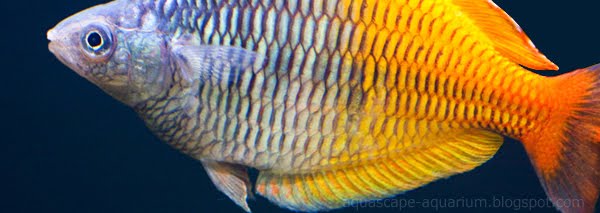Freshwater Tropical Fish | Rainbowfishes
 Rainbowfishes are another tropical fish species suited for freshwater aquarium plants. An additional plus with Rainbowfish is that they leave plants alone – they will not eat them nor uproot them. They did not grew popular among aquarists until fairly recently, which is actually a bit strange considering their beauty and sturdiness.
Rainbowfishes are another tropical fish species suited for freshwater aquarium plants. An additional plus with Rainbowfish is that they leave plants alone – they will not eat them nor uproot them. They did not grew popular among aquarists until fairly recently, which is actually a bit strange considering their beauty and sturdiness.It's a family of small, colorful, freshwater fish that are indigenous to Africa, Australia, Madagascar, New Guinea, and other South Asian Islands. Rainbowfish can vary in size (1" to 6") and belong to the family Melanotaenia, the blue-eyed rainbows to the family Pseudomuglidae, the Rice fish to the family Orziatidae and the Silversides to the family Atherinidae. They inhabit streams, creeks, lakes, and brackish waters. Rainbow fish are normally very active swimmers, and are often very hardy and fit well in many community tanks.
 Depending on the species, pH requirements can vary from 6.5 to 8.0 and temperatures should be maintained between 25 to 28° C. Good filtration and regular partial water changes are important. With a few exceptions all these fish like medium hard to hard water and the pH on the Alkaline side of neutral. Good water quality is a must and as the quality decreases the coloration on the fish tend to fade and get washed out.
Depending on the species, pH requirements can vary from 6.5 to 8.0 and temperatures should be maintained between 25 to 28° C. Good filtration and regular partial water changes are important. With a few exceptions all these fish like medium hard to hard water and the pH on the Alkaline side of neutral. Good water quality is a must and as the quality decreases the coloration on the fish tend to fade and get washed out.Rainbowfishes is also an excellent choice for aquarists who like their fish to spawn in the aquarium. They have very similar breeding habits, their food requirements are similar, and adapt to a wide range of water chemistry. All are of good-natured temperament and will live harmoniously, more or less, with one another.
 Similiar to Tetras or Rasboras, Rainbowfish is a schooling fish and should be kept in groups consisting of at least six individuals, preferably not less than 10-15. This is not only beneficial for the fish, it is also much more beautiful to look at a large school of shimmering Rainbow fish than one or a few shy individuals that spend most of their time hiding.
Similiar to Tetras or Rasboras, Rainbowfish is a schooling fish and should be kept in groups consisting of at least six individuals, preferably not less than 10-15. This is not only beneficial for the fish, it is also much more beautiful to look at a large school of shimmering Rainbow fish than one or a few shy individuals that spend most of their time hiding.Keeping several males together will also make them develop more vibrant colors, since they need to compete with each other for female attention. Juveniles often show little of their stunning adult colors. The natural habitat of Rainbowfish is filled with aquatic plants and they will therefore appreciate a planted aquarium with some open space available for these active and energetic fishes to swim around in. A good plant to use is the Java moss as it is native to the region and can also serve as a spawning medium.









